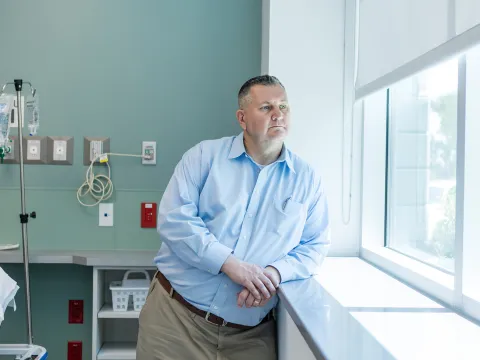- AdventHealth

Choose the health content that’s right for you, and get it delivered right in your inbox.
When it comes to pelvic floor dysfunction, symptoms can range from slightly embarrassing to downright debilitating. For example, some women may feel like their lives revolve around their lady's room schedule, searching for a public restroom even though they went to the bathroom 20 minutes ago. Some of these women may also experience severe pelvic pain, backaches, bowel problems or pain during intercourse.
According to the National Institutes of Health, between a quarter and half of American women experience pelvic floor issues. While pelvic floor dysfunction becomes more common with age, it’s not something you have to learn to live with. Pelvic issues are highly treatable, and our experts understand these sensitive concerns. With the right information and a proper treatment plan, you can find relief from your symptoms and regain your confidence.
Let's start by learning more about pelvic floor health and pelvic floor dysfunction.
What is the pelvic floor?
The pelvic floor is a combination of muscles, ligaments and tissues that act like a hammock to support organs, such as the bladder, uterus, vagina and rectum in the lowest part of the pelvis. In essence, the pelvic floor prevents these organs from falling down or out of the body and helps make sure that they are functioning properly.
What is pelvic floor dysfunction?
Pelvic floor dysfunction refers to a wide range of disorders that occur when pelvic floor muscles are weak, tight or torn. If the muscles become weak or the ligaments or tissues are stretched or damaged, the pelvic organs or small intestine may drop down and protrude into the vagina. If the disorder is severe, the organs may protrude through the opening of the vagina and outside the body.
What causes pelvic floor dysfunction?
In general, pelvic floor dysfunction is due to weakened pelvic muscles or tears in the connective tissue. A damaged pelvic floor cannot continue to provide the support that your organs need to work effectively. As this structure weakens, normal functioning of the bowel, bladder, uterus, vagina and rectum can be affected.
Most of the causes of pelvic floor dysfunction are unknown. Traumatic injuries to the pelvic area, strenuous exercise and complications from vaginal childbirth can all contribute to this condition.
What are the symptoms of pelvic floor dysfunction?
Women with pelvic floor disorders may experience:
- Burning during urination
- Chronic pelvic pain that radiates to the groin, abdomen and back
- Difficulty with defecation and constipation
- Painful menstrual periods
- Painful sexual intercourse
- Strong or frequent urge to urinate
- Urinary incontinence
- Vaginal burning
If you’re unsure if your symptoms are related to pelvic floor disorder, or even if you experience only a few of the symptoms listed above, talk with your doctor for support.
Types of Pelvic Floor Dysfunction
The three main areas of pelvic floor dysfunction are urinary incontinence, fecal incontinence and pelvic organ prolapse.
Urinary Incontinence
Urinary incontinence is a loss of bladder control and is the most common pelvic floor disorder. Symptoms can range from mild leaking to uncontrollable wetting. It can happen to anyone, but it becomes more common with age. Women experience urinary incontinence twice as often as men.
It can be caused by a number of conditions, including a weakening of the muscles that control the bladder valve. A major symptom is the frequent urge to urinate; other symptoms include pressure on the bladder and a feeling that the bladder has not completely emptied. There are several different types of urinary incontinence, and the severity can vary from person to person.
Fecal Incontinence
Fecal incontinence is the inability to control bowel movements, causing stool to leak unexpectedly from the rectum. Also called bowel incontinence, fecal incontinence ranges from an occasional leakage of stool while passing gas to a complete loss of bowel control. Common causes of fecal incontinence include diarrhea, constipation and muscle or nerve damage. The muscle or nerve damage may be associated with aging or with giving birth.
Pelvic Organ Prolapse
Pelvic organ prolapse occurs when a pelvic organ, such as your bladder, drops (or prolapses) from its normal place in your lower belly and pushes against the walls of your vagina. While these conditions are usually not associated with serious health risks, they can cause major discomfort with symptoms that include a heavy feeling or like something is falling out of the vagina, a pulling sensation or pressure in the lower abdomen or pelvis, pain during intercourse and frequent urinary infections due to a reduced ability to release urine from the urethra. This can happen when the muscles that hold your pelvic organs in place get weak or stretched from childbirth or surgery.
Treating Pelvic Floor Dysfunction
With an expert treatment team, pelvic floor dysfunction can often be successfully treated without surgery through physical therapy and a combination of other treatment options.
Treatments for pelvic floor dysfunction can include:
- Biofeedback: Biofeedback is a nonsurgical technique that uses special sensors and video to monitor the pelvic floor muscles as the patient attempts to relax or contract them.
- Medicine: Medicine is sometimes prescribed to treat certain bladder control problems, prevent loose stools or control frequent bowel movements.
- Relaxation techniques: Your physician or physical therapist may recommend relaxation techniques such as warm baths, yoga and exercises.
- Strengthening exercises: Strengthening exercises, also known as Kegels, involve squeezing and relaxing the pelvic floor muscles. If performed correctly and routinely, these exercises may improve the symptoms of prolapse.
- Surgery: Sometimes, surgery may be necessary to treat severe pelvic floor dysfunction.
Treatment looks different for everyone, but your care team will work with you to create a custom plan to meet your unique needs.
We’re Here to Support You
Many women may not feel comfortable discussing their symptoms with their doctors, but these disorders are very common medical conditions that can be treated successfully.
If you have a pelvic health concern, don't hesitate to learn more about your treatment options. Our urogynecology experts treat the full range of pelvic health conditions and offer pelvic rehabilitation services to help improve your health and restore your quality of life. We’re here to help you feel whole again in body, mind and spirit.


